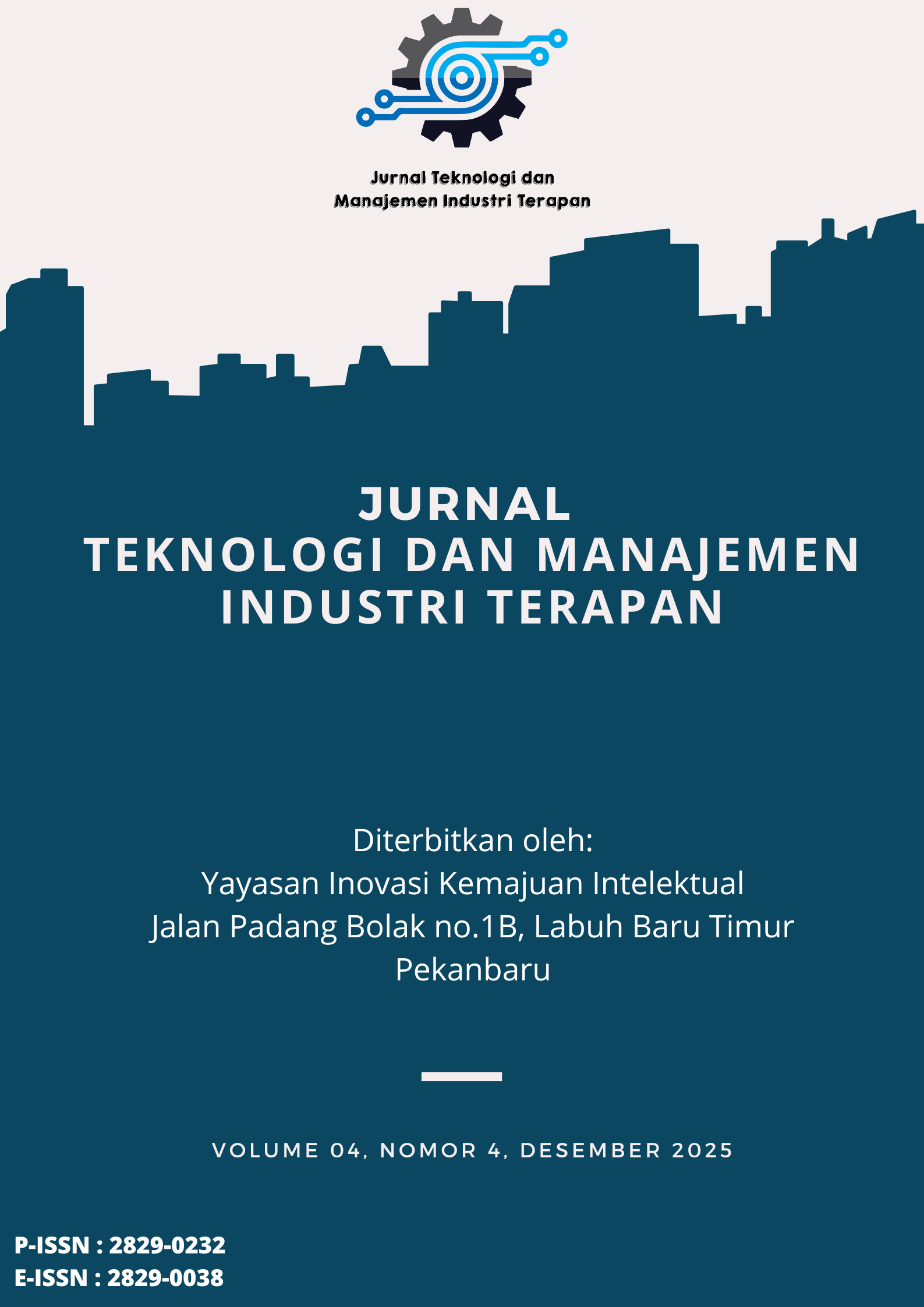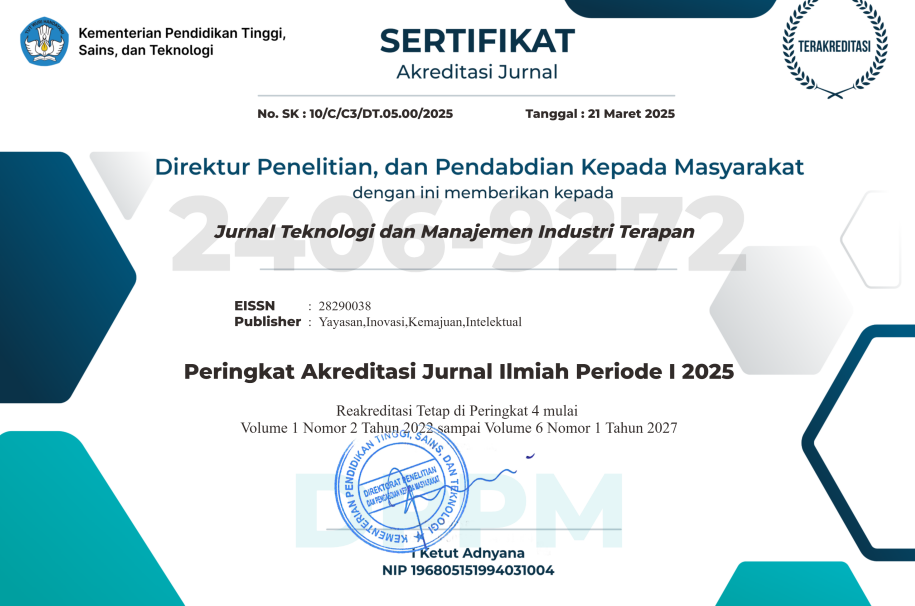Fault Tree Analysis dalam Identifikasi Faktor Penyebab Cedera Mata Akibat Produk Cair di Industri Farmasi
DOI:
https://doi.org/10.55826/jtmit.v4i4.1229Keywords:
Cidera Mata, Paparan Cairan, Analisis Pohon Kesalahan, Industri Farmasi, Keselamatan Di Tempat KerjaAbstract
Penelitian ini bertujuan untuk mengidentifikasi faktor-faktor yang menyebabkan cedera mata akibat paparan produk cair di lingkungan industri farmasi, dengan menggunakan pendekatan Fault Tree Analysis (FTA). Data terkait kecelakaan kerja diperoleh melalui analisis laporan insiden, wawancara mendalam, serta observasi langsung di sebuah perusahaan farmasi yang berlokasi di Jawa Barat. Temuan studi menunjukkan bahwa cedera pada mata merupakan jenis kecelakaan kerja yang paling sering terjadi, dengan total 8 kasus yang tercatat, melebihi jumlah insiden kecelakaan lainnya. Melalui penerapan metode FTA, teridentifikasi 11 basic event yang berkontribusi terhadap terjadinya kecelakaan tersebut. Faktor-faktor utama yang menjadi pemicu antara lain ketidakpatuhan dalam penggunaan alat pelindung diri (APD), kurangnya pelatihan keselamatan kerja yang berkelanjutan, kondisi lingkungan kerja yang tidak memenuhi standar keselamatan, serta lemahnya implementasi kebijakan K3 di tingkat manajerial. Hasil analisis Minimal Cut Set mengindikasikan bahwa kombinasi antara perilaku tidak aman dari pekerja dan ketidakefisienan kebijakan manajemen menjadi penyebab kritis terjadinya insiden. Berdasarkan hasil tersebut, strategi pencegahan diarahkan pada peningkatan kepatuhan terhadap penggunaan APD, pelaksanaan pelatihan keselamatan secara berkala, serta penguatan sistem pengawasan K3. Pendekatan FTA terbukti memberikan kontribusi signifikan dalam mengidentifikasi akar penyebab kecelakaan, sehingga dapat dijadikan dasar untuk merancang program keselamatan dan kesehatan kerja yang lebih terarah dan efektif.
References
[1] R. Octavariny, “Jurnal Aisyah : Jurnal Ilmu Kesehatan Factors Associated with The Risk of Eye Injury on Industrial Welding Workers in the Informal Sector in Barumun District , Padang Lawas Regency,” vol. 5, no. 1, pp. 161–164, 2021, doi: 10.30604/jika.v5i1.833.
[2] S. H. Rauchman, B. Locke, J. Albert, J. De Leon, M. R. Peltier, and A. B. Reiss, “Toxic External Exposure Leading to Ocular Surface Injury,” 2023.
[3] J. Zara, S. M. Nordin, and A. S. N. Isha, “Influence of communication determinants on safety commitment in a high-risk workplace: a systematic literature review of four communication dimensions,” Front. Public Heal., vol. 11, no. August, 2023, doi: 10.3389/fpubh.2023.1225995.
[4] J. H. Song and S. Y. Park, “Safety and efficacy of combined acupuncture (body and intradermal acupuncture) for dry eye disease: study protocol for a pilot, single-centre, assessor-blinded, randomised, artificial tear drop-controlled trial at Naju Dongshin University Korean Medicine ,” BMJ Open, vol. 14, no. 1, pp. 1–7, 2024, doi: 10.1136/bmjopen-2023-077913.
[5] I. H. El-adaway and D. Ph, “Enhancing Safety and Well Being of Aging Workforce within the Transportation Sector An Association Rule Data Mining Approach for Understanding Causes and Impacts of Worker Compensation Claims,” Univ. Nebraska-Lincoln. Mid-America Transp. Center., 2025.
[6] R. N. Islamsyah, M. H. N., & Sari, “View of Analysis of Factors Causing Work Accidents in Steel Plate Production with FTA and PDCA Methods at PT. XYZ.pdf,” J. Artif. Intell. Eng. Appl., 2025.
[7] J. Kang, T. Su, J. Li, Z. Wang, and J. Zhang, “Research on risk evolution , prevention , and control of fire and explosion accidents in hydrogen refueling stations based on the AcciMap-FTA model,” Process Saf. Environ. Prot., vol. 194, no. December 2024, pp. 107–118, 2025, doi: 10.1016/j.psep.2024.12.033.
[8] C. Maharani and M. Sayuti, “Analysis of Occupational Health and Safety Hazard Risk Using Hazard and Operability and Fault Tree Analysis Methods,” Int. J. Eng. Sci. Inf. Technol., vol. 5, no. 1, pp. 117–127, 2025.
[9] F. Ojiemhende, O. Oluseye, and A. Sidiq, “Fault Tree Analysis and its Modifications as Tools for Reliability and Risk Analysis of Engineering Systems -An Overview International Journal of Research Publication and Reviews Fault Tree Analysis and its Modifications as Tools for Reliability and Risk ,” no. January, 2022.
[10] M. Yazdi, “Fault tree analysis improvements : A bibliometric analysis and literature review,” no. November 2022, pp. 1639–1659, 2023, doi: 10.1002/qre.3271.
[11] J. G. Ramaekers, “Fatigue in Aviation : Safety Risks , Preventive Strategies and Pharmacological Interventions,” Front. Physiol., vol. 12, no. September, 2021, doi: 10.3389/fphys.2021.712628.
[12] S. Ahmad et al., “Industrial hazards and safety management in pharmaceutical industry,” Authorea Prepr., 2022.
[13] L. He et al., “A Case Study of Accident Analysis and Prevention for Coal Mining Transportation System Based on FTA-BN-PHA in the Context of Smart Mining Process,” 2024.
[14] Y. J. Ahn, Y. U. Yu, and J. K. Kim, “Accident cause factor of fires and explosions in tankers using fault tree analysis,” J. Mar. Sci. Eng., vol. 9, no. 8, 2021, doi: 10.3390/jmse9080844.
[15] A. Ismail and M. Nur, “Analisis Potensi Bahaya Keselamatan dan Kesehatan Kerja Menggunakan Metode FTA ( Fault Tree Analysis ) dan TRA ( Task Risk Assesment ) pada Industri Pandai Besi,” vol. 25, no. 1, pp. 891–898, 2025, doi: 10.33087/jiubj.v25i1.5884.
[16] R. Bastuti, S., & Alfatiyah, “View of ANALYSIS OF WORK ACCIDENTS DURING THE PLUMBING INSTALLATION PROCESS USING THE FAULT TREE ANALYSIS METHOD.pdf,” J. Rekayasa Mesin, 2024.
[17] A. P. G. Wijnands, D. W. de Lange, and S. J. Rietjens, “Preventing occupational chemical eye injuries: important lessons from poison information centres,” Clin. Toxicol., vol. 61, no. 8, pp. 573–576, 2023, doi: 10.1080/15563650.2023.2250068.
[18] C. Liu, J. Li, and D. Zhang, “Mine Ground Gas Transportation System,” 2024.
[19] C. Ş. Ali Cemal TÖZ1 , Müge BÜBER , Burak KÖSEOĞLU1, “Analysis of Collision Accidents in Maritime Transportation by FTA Method Deniz,” Turkish J. Marit. Mar. Sci. DOI, vol. 1, pp. 15–30, 2022, doi: 10.52998/trjmms.971042.
Downloads
Published
Issue
Section
License
Copyright (c) 2025 Sofian Bastuti, Hotma Antoni Hutahaean, Sofian Bastuti

This work is licensed under a Creative Commons Attribution-NonCommercial-ShareAlike 4.0 International License.


















